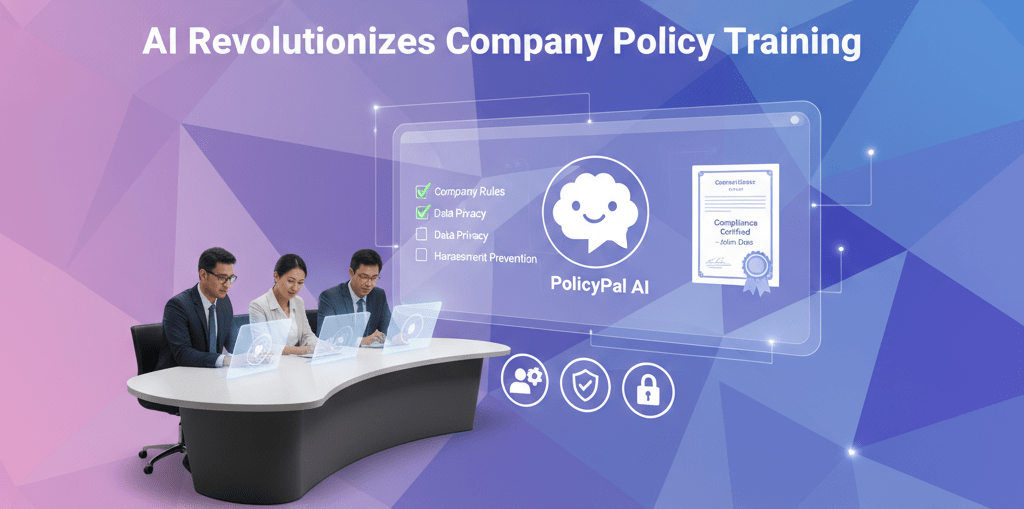“Deploy a Company Policy Training AI for engaging, scenario-based modules with instant feedback.”
Let’s face it. “Company policy training” often conjures images of thick binders, endless PDFs, and minds wandering. Employees click through slides, initial a document, and then promptly forget half of what they just “learned.” This old way? It just doesn’t work. We need a fundamental change. We need something that actually sticks.
The truth is, passive reading is a recipe for disaster. It breeds misunderstanding, opens the door to compliance risks, and leaves your organization vulnerable. But what if there was a better way? An active, engaging approach that truly embeds policy knowledge into your team’s everyday work? There is. And it’s powered by AI.
Imagine this: instead of slogging through a static document, your employees engage in a dynamic conversation. They face realistic scenarios, answer pointed questions, and get instant, personalized feedback. This isn’t just about reading; it’s about doing, understanding, and truly learning. An AI agent, purpose-built to align with your company’s policies, makes this a reality.

The Old Way: A Leaky Bucket of Knowledge
Consider how most companies currently handle policy training. It usually goes something like this:
- The Mammoth Handbook: A digital or physical tome full of legalese. Employees are told to “read and understand.”
- The Click-Through Carousel: A series of slides, often dense with text, accompanied by a monotone voiceover. Engagement? Minimal.
- The Acknowledgment Signature: A digital checkbox or a physical sign-off, often done without genuine comprehension.
- The “Hope and Pray” Strategy: HR and compliance teams cross their fingers, hoping employees remember key points when it matters most.
This traditional approach is fundamentally flawed. Here’s why:
- Information Overload: Too much information, presented all at once, leads to cognitive overload. Our brains simply can’t process and retain it effectively.
- Lack of Engagement: Passive learning is boring. When employees are bored, their minds drift. They disengage. Learning stops.
- No Immediate Feedback: If an employee misunderstands a policy, they often don’t realize it until a mistake happens. The learning opportunity is lost.
- Inconsistent Understanding: Everyone interprets text differently. Without clarification or scenario-based testing, your team will have varying levels of comprehension of the policy. This creates gaps.
- Difficulty with Updates: Policies change. Updating and redistributing physical handbooks or re-recording endless training modules is a massive logistical headache.
These issues directly impact your bottom line and your company’s safety. Misunderstanding a security policy can lead to a data breach. Failing to follow a safety protocol can result in an accident. Non-compliance with regulations can result in substantial fines. The stakes are simply too high to stick with outdated methods.
The New Way: Active Learning with an AI Agent
Now, let’s picture a different scene—a new hire logs into their training portal. Instead of a PDF, they see a friendly chat interface. This is their AI policy trainer.
The AI kicks off the new hire policy training with a warm welcome. It doesn’t just present information; it prompts interaction. “Welcome to the team! Our code of conduct is vital. Let’s explore it. Tell me, what do you think is our most important value when interacting with customers?”
This isn’t a quiz yet. It’s a conversation. It’s an exploration.
As the training progresses, the AI delves into specific policies and procedures. For instance, in a section on security policy awareness, it might present a scenario:
“You receive an email from someone claiming to be from IT, asking you to click a link to ‘verify your account.’ What’s your first step?”
The employee types their answer. The AI processes it if the answer is correct, “Excellent! You’re right. Always check the sender and report suspicious emails. This protects our data.”
If the answer is incorrect or incomplete, the AI gently guides them: “That’s a good thought, but let’s refine it. What’s the safest and most immediate action to take before clicking anything or replying?” It might then offer a hint or direct them to the relevant policy section for review.
This is the power of an interactive training module driven by AI. It turns static information into a dynamic, personalized learning experience.
Why an AI Agent is Your Best Trainer
Let’s break down the core advantages of using an AI for your company policy training:
- Authentic Engagement, Not Just Passive Consumption: AI Makes Learning an Active Process. It doesn’t just deliver content; it demands interaction. Employees can’t passively skim. They must respond, analyze, and apply what they’ve learned. This level of engagement is crucial for moving information from short-term memory to long-term understanding. Think about it: if you’re asked to explain something in your own words, you remember it much better than if you just read it. The AI facilitates this “explaining” process. It truly tests comprehension.
- Immediate and Consistent Feedback: This is a game-changer. In traditional training, feedback is often delayed, generic, or nonexistent. An AI provides instant validation for correct answers and immediate course correction for incorrect ones. This rapid feedback loop reinforces learning and prevents misconceptions from taking root. Furthermore, the feedback is perfectly consistent. Every employee receives the same, accurate guidance, ensuring uniform understanding across the organization: no trainer bias, no missed details.
- Scenario-Based Learning for Real-World Application: Policies are theoretical until they’re applied. An AI excels at presenting realistic scenarios. “What is the correct procedure if you witness a safety violation?” is a far more effective training question than simply asking “What is Section 3.1.2 of the safety manual?” The AI crafts situations that mimic real-life challenges, forcing employees to think critically and apply policy knowledge in context. This practical application significantly improves knowledge retention. When employees can visualize themselves using the policy, they remember it better.
- Personalized Learning Paths: Not every employee starts with the same knowledge base. An AI can adapt. If an employee consistently performs well in a specific area, the AI can move more efficiently through that section. If they struggle with another, the AI can offer additional resources, rephrase explanations, or present more practice scenarios to help them. This personalized approach ensures that training is efficient and effective for everyone, addressing individual needs rather than relying on a one-size-fits-all approach. It helps ensure every single employee reaches the required level of understanding.
- 24/7 Accessibility and Scalability: An AI agent is always on duty. Employees can access training modules at their convenience, whether during work hours, at home, or while traveling. This flexibility eliminates logistical hurdles and simplifies HR automation for training. Plus, an AI can train ten employees or ten thousand employees with the same efficiency. It scales effortlessly with your company’s growth, making it ideal for large organizations or those with rapid expansion plans.
- Reduced Compliance Risk and Improved Audit Trails: A significant benefit of using AI for compliance training is the ability to thoroughly track training completion and understanding. The AI can log every interaction, every answer, and every correct or incorrect response. This creates a detailed, auditable record of who trained on what, when, and how well they understood it. This robust documentation is invaluable for demonstrating compliance with regulatory bodies and significantly helps to reduce compliance risk. You move from hoping employees understand to having verifiable proof of their comprehension.
- Cost-Effectiveness and Efficiency: Although there’s an initial setup cost, the long-term cost savings are substantial. You reduce the need for expensive in-person training sessions, travel costs, and the time commitment of human trainers. The AI can handle repetitive training tasks, freeing up your HR and compliance teams to focus on more strategic initiatives. This enables your training budget to go further and your team to become more efficient.
- Consistency and Fairness: Human trainers, however skilled, can sometimes inadvertently introduce bias or inconsistencies in their explanations. An AI agent, however, delivers the same information and feedback every single time. This ensures fairness and consistency for all employees, guaranteeing that everyone receives the same foundational understanding of your policies. This uniform delivery builds a stronger, more cohesive workforce.
- Engaging Training Content for Better Retention: Let’s Revisit the Core Problem: Boring Training. AI can make training truly engaging. It can use conversational language, varied question types, and even integrate multimedia elements if designed well. The interactive nature itself is inherently more engaging than passive reading. When employees are engaged, they remember more. It’s that simple. This translates directly into better employee handbook acknowledgment because they’ve actively wrestled with and understood the material, not just skimmed it.
Implementing AI for Your Policy Training: What to Consider
Bringing an AI agent into your training strategy isn’t about replacing human interaction entirely; it’s about augmenting it. Instead, it’s about optimizing the foundational transfer of knowledge. Here are a few things to keep in mind:
- Start with Your Policies: The AI is only as good as the information it’s trained on. Ensure your company policies are clear, comprehensive, and up-to-date.
- Design Engaging Scenarios: Don’t just dump text into the AI. Craft compelling, realistic scenarios and questions that challenge employees to think.
- Iterate and Improve: Like any training program, AI-driven training should be continuously reviewed and improved. Analyze the data the AI collects to identify common misunderstandings and refine your content.
- Maintain a Human Touch: While AI handles the bulk of the training, human HR and compliance teams remain crucial for addressing complex, nuanced situations that may arise, as well as for in-depth discussions that extend beyond the scope of automated training. The AI handles the basics, enabling humans to concentrate on more complex issues.
Introducing Scalewise.ai: Your Partner in Modern Compliance Training
The idea of building an AI agent might sound daunting, especially for HR and compliance teams who aren’t tech experts. That’s where Scalewise.ai comes in.
Scalewise.ai is the perfect tool for modern compliance training. It’s a free, no-code AI Agent Builder. What does that mean for you? It means you don’t need to write a single line of code or hire expensive developers.
Scalewise.ai allows HR and compliance teams to transform their static policy manuals into an interactive training agent that employees can engage with 24/7. You simply feed your policy documents, your code of conduct, your safety guidelines—whatever you need—into the platform. Then, you define the types of questions and scenarios you want the AI to present.
Think about it:
- Take your employee handbook. Upload it.
- Design quiz questions based on key sections of the code of conduct.
- Create hypothetical situations related to security policy awareness.
- Develop prompts for new hire policy training.
Scalewise.ai takes your content and generates an intelligent, conversational agent. Your employees then interact with this agent, asking questions, responding to scenarios, and getting immediate feedback. It’s truly revolutionary.
This tool makes it incredibly easy to:
- Build Custom AI Trainers: Tailor the AI agent specifically to your company’s unique policies and culture.
- Ensure Uniform Policy Understanding: Every employee gets the same, consistent, and accurate training.
- Boost Engagement and Retention: Interactive learning means employees actually remember what they learn.
- Reduce Compliance Risk: Documented interactions provide clear audit trails of policy comprehension, ensuring a comprehensive understanding of policy adherence and compliance.
- Automate Training: Free up valuable HR and compliance time by automating repetitive training tasks.
- Access Training Data: Get insights into common areas of confusion, allowing you to refine your policies and training content.
Scalewise.ai isn’t just about making training easier; it’s about making it effective. It closes the loop between reading a policy and truly understanding and applying it. It transforms a necessary chore into an engaging, valuable learning experience for your entire team.
The Future of Policy Training is Here
The days of expecting employees to simply “read the manual” and absorb complex policies are over. The modern workplace demands a contemporary solution. An AI agent provides that solution. It shifts the paradigm from passive information consumption to active, scenario-based learning.
By adopting AI for your company policy training, you’re not just updating a process; you’re investing in your employees’ understanding, safeguarding your company against compliance risks, and fostering a culture of informed decision-making.
Ready to make your policies truly stick? Ready to empower your HR and compliance teams with a tool that truly works? Explore Scalewise.ai. It’s time to transform your training from a leaky bucket into a solid foundation of knowledge.
Frequently Asked Questions (FAQs)
Q1: What exactly is an AI agent for company policy training?
An AI agent for company policy training is a software program designed to interact with employees, typically through a chat interface. It’s “trained” on your company’s specific policy documents, code of conduct, safety guidelines, and other relevant internal documents. It acts as an interactive tutor, presenting information, asking questions, providing scenarios, and giving immediate feedback to ensure employees understand and retain policy knowledge.
Q2: How is AI training better than traditional methods like reading handbooks or watching videos?
AI training is superior because it’s active and engaging, unlike passive methods. Employees must interact with customers, answer questions, and apply policies to various scenarios. This dynamic process significantly improves knowledge retention. It also offers immediate, consistent, and personalized feedback, correcting misunderstandings in real-time. Traditional methods often lack engagement, provide delayed or no feedback, and lead to inconsistent understanding.
Q3: Can an AI agent really understand complex company policies?
Yes, modern AI, huge language models, can be very effective at understanding and interpreting complex text. When properly trained on your specific policy documents, the AI agent can accurately reference information, explain concepts, and formulate relevant questions based on the nuances of your policies. The key is providing the AI with clear, comprehensive policy documents as its knowledge base.
Q4: Will using an AI agent replace my HR or compliance team?
No, absolutely not. An AI agent is a tool designed to support and augment your HR and compliance teams, not replace them. It automates the foundational, repetitive aspects of policy training, freeing up your human teams to focus on more complex issues, individual employee counseling, strategic initiatives, and handling unique situations that require human judgment and empathy. It enhances the efficiency and effectiveness of your existing teams.
Q5: How does AI training help reduce compliance risk?
AI training helps reduce compliance risk in several ways. First, it ensures a uniform and deeper understanding of policies across the organization, meaning fewer unintentional violations. Second, it provides a robust, auditable record of who completed training, when, and their level of comprehension. This detailed documentation is invaluable for demonstrating compliance to regulatory bodies and auditors, as it proves that your company has taken proactive steps to educate its workforce.
Q6: Is AI training suitable for all types of company policies?
Generally, yes. AI training can effectively cover a wide range of policies, including code of conduct, IT security, data privacy, health and safety, HR policies, anti-harassment policies, and more. Any policy that can be clearly articulated in text can be used to train an AI agent. The effectiveness lies in how well the policies are structured and how engaging the scenarios and questions are.
Q7: How long does it take to set up an AI policy training agent?
The setup time can vary depending on the complexity and volume of your policies. However, platforms like Scalewise.ai are designed to be no-code and user-friendly, allowing HR and compliance teams to get an agent up and running relatively quickly. You’ll spend time uploading your documents, defining key concepts, and crafting your initial training scenarios and questions, but the technical build is streamlined.
Q8: Can employees ask the AI agent questions outside of the pre-set training modules?
Yes, this is one of the significant benefits of an interactive AI agent. Employees can treat the AI as a 24/7 policy expert. They can ask specific questions about a policy at any time and receive instant, accurate answers without having to sift through documents or wait for an HR representative. This on-demand access is incredibly valuable for quick clarification.
Q9: How do I know if employees are actually learning from the AI agent?
Most AI training platforms provide robust analytics and reporting capabilities. You can track completion rates, performance on quizzes and scenarios, areas where employees commonly struggle, and even the types of questions employees ask the agent. This data provides clear insights into knowledge retention and regions where your policies or training content might need refinement.
Q10: What kind of support is available if I use a platform like Scalewise.ai?
While Scalewise.ai is designed to be intuitive and easy to use, comprehensive support is typically available. This includes documentation, tutorials, and often direct customer support channels. The goal is to ensure that non-technical users can successfully build and manage their AI training agents without needing specialized IT knowledge.





